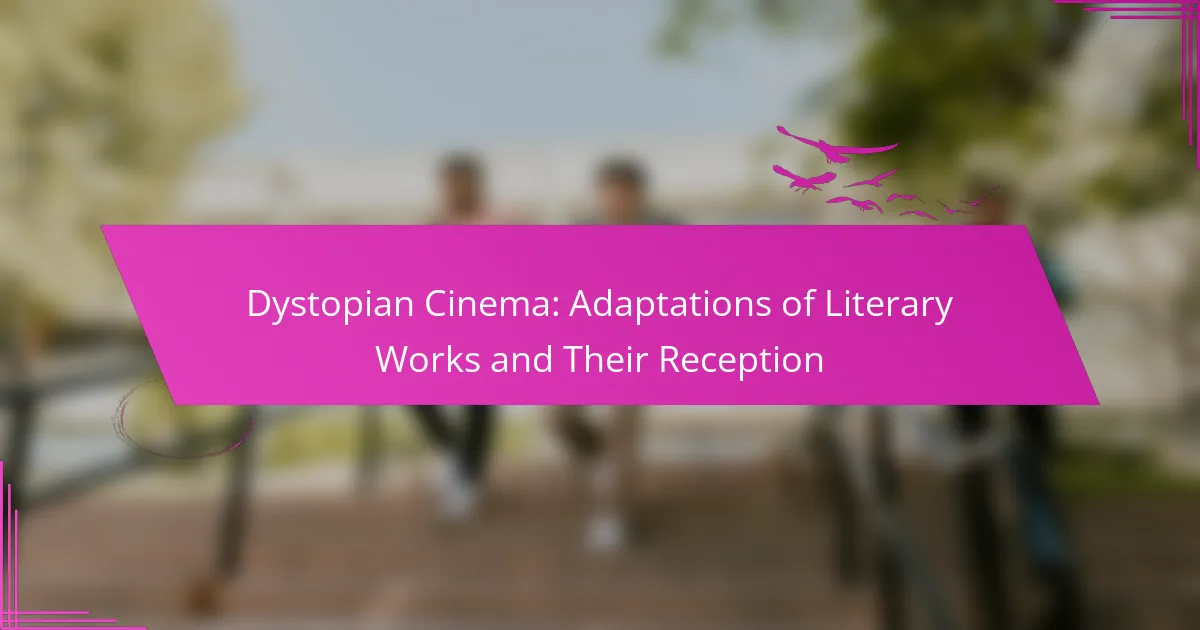Dystopian cinema adaptations of literary works significantly shape audience perceptions and cultural critiques. This article explores the influence of source material on narrative depth, regional reception variations, and the unique attributes that enhance viewer engagement. It also examines common pitfalls in adaptations and future trends in the genre.
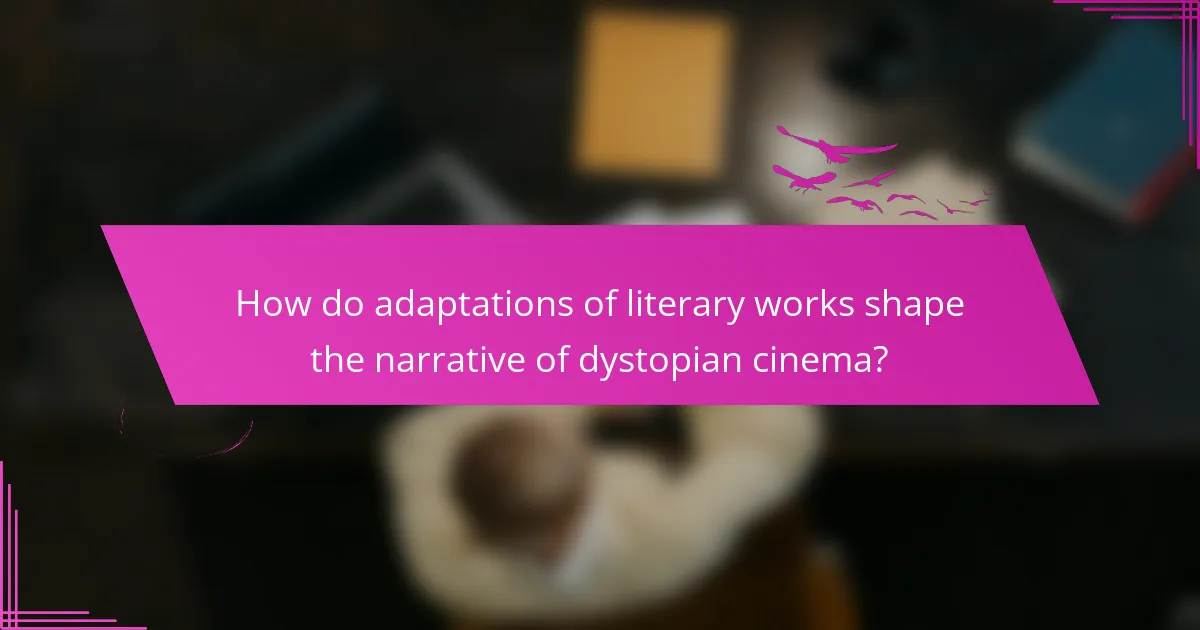
How do adaptations of literary works shape the narrative of dystopian cinema?
Adaptations of literary works significantly influence the narrative of dystopian cinema by providing rich source material and thematic depth. These adaptations often highlight societal fears and critiques, shaping audience perceptions. For example, films like “The Handmaid’s Tale” and “1984” amplify the original narratives, enhancing emotional engagement and drawing parallels to contemporary issues. The unique attributes of these adaptations, such as visual storytelling and character development, create a distinct cinematic experience that resonates with viewers. As a result, the reception of dystopian films often reflects broader cultural concerns, making them relevant across different eras.
What are the key themes commonly explored in dystopian adaptations?
Key themes in dystopian adaptations often include authoritarianism, environmental collapse, technological control, and social inequality. These narratives explore the consequences of extreme societal changes and human behavior under oppressive regimes. Adaptations frequently highlight the struggle for individuality and resistance against conformity. The reception of these films reflects societal anxieties and the relevance of their themes to contemporary issues.
Which literary genres are most frequently adapted into dystopian films?
Dystopian films frequently adapt science fiction, speculative fiction, and classic literature. These genres explore themes of societal collapse, totalitarianism, and human resilience, making them ideal for cinematic interpretation. Notable examples include adaptations of George Orwell’s “1984,” Aldous Huxley’s “Brave New World,” and Margaret Atwood’s “The Handmaid’s Tale.” Each adaptation emphasizes unique attributes of the original works, enhancing their cultural relevance and audience reception.
How do filmmakers interpret the source material in dystopian adaptations?
Filmmakers interpret source material in dystopian adaptations by emphasizing themes, character development, and visual storytelling. They often distill complex narratives into accessible cinematic experiences.
Adaptations like “The Handmaid’s Tale” showcase how filmmakers can highlight societal critiques through visual cues. The unique attribute of this adaptation lies in its focus on female empowerment against oppressive regimes.
Additionally, filmmakers may alter plot elements to resonate with contemporary audiences. For instance, “The Hunger Games” modifies character arcs to reflect modern issues like inequality and rebellion.
Overall, the reception of these adaptations hinges on their ability to balance fidelity to the source while innovatively engaging viewers. This dynamic interpretation shapes audience perceptions of the original literary works.
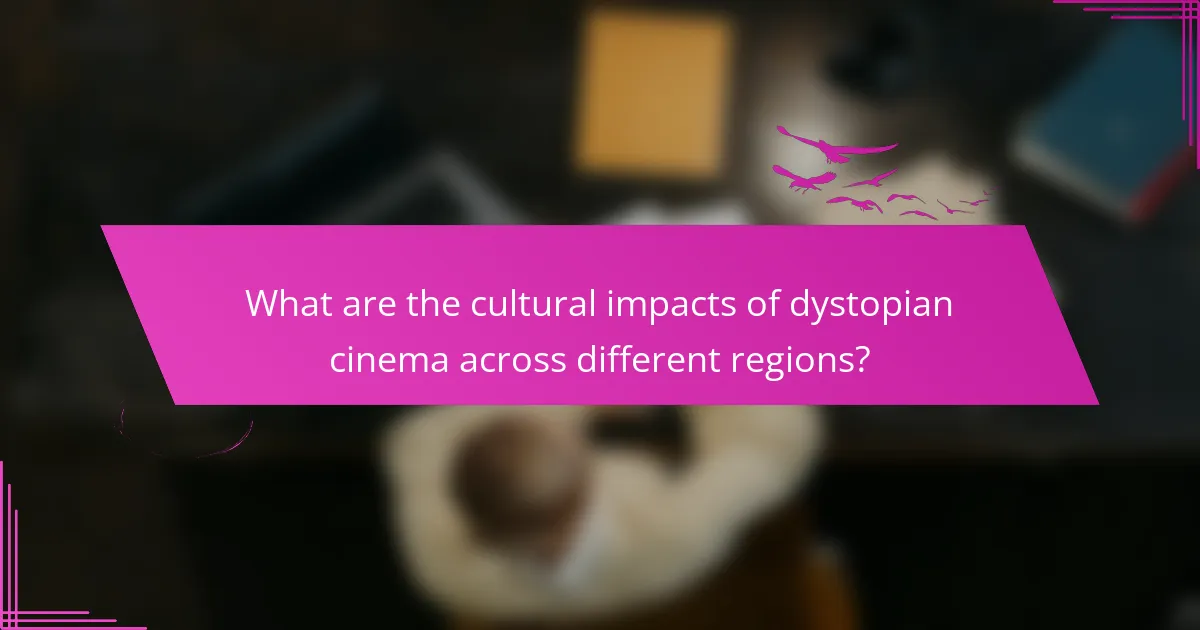
What are the cultural impacts of dystopian cinema across different regions?
Dystopian cinema profoundly influences cultural perceptions and social critiques across various regions. In North America, films like “The Hunger Games” reflect anxieties about inequality and authoritarianism. European adaptations often explore themes of surveillance and individualism, as seen in “1984” and “Fahrenheit 451.” In Asia, movies such as “Battle Royale” challenge societal norms and youth culture, emphasizing violence and conformity. Each region’s reception varies, shaped by local historical contexts and societal issues, ultimately fostering dialogue about freedom and human rights.
How does audience reception vary between North American and European adaptations?
Audience reception of dystopian cinema adaptations varies significantly between North America and Europe due to cultural differences and thematic interpretations. North American audiences often favor action-oriented narratives and clear moral binaries, while European adaptations tend to explore complex social critiques and philosophical questions.
For example, the adaptation of George Orwell’s “1984” received mixed reviews in North America, focusing on its suspenseful elements, whereas European versions emphasize the psychological and societal implications of totalitarianism. This divergence reflects unique cultural values and historical contexts that shape audience expectations and interpretations.
Additionally, box office performance highlights these differences. North American adaptations generally achieve higher commercial success, driven by marketing strategies that prioritize entertainment value. In contrast, European films may garner critical acclaim but struggle with mainstream appeal, showcasing a preference for artistic expression over mass-market entertainment.
Overall, understanding these variations in audience reception can enhance the adaptation process, ensuring that filmmakers cater to the expectations and cultural nuances of their target demographic.
What role do social issues play in the reception of dystopian films?
Social issues significantly influence the reception of dystopian films by shaping audience perceptions and emotional responses. These films often reflect societal anxieties, serving as a critique of contemporary issues such as inequality, environmental degradation, and authoritarianism. For example, films like “The Hunger Games” and “Children of Men” resonate with audiences due to their portrayal of class struggles and governmental control, drawing parallels to real-world concerns. As a result, viewers often engage more deeply with these narratives, leading to discussions about the implications of social issues depicted in the films. The unique attribute of dystopian cinema lies in its ability to provoke thought and inspire action regarding pressing societal challenges.

Which adaptations have achieved critical acclaim and why?
Several adaptations of literary works in dystopian cinema have achieved critical acclaim due to their thought-provoking themes and visual storytelling. Notable examples include “The Handmaid’s Tale,” praised for its exploration of gender oppression, and “Children of Men,” recognized for its gripping narrative and cinematography. “1984” remains influential for its chilling portrayal of totalitarianism. Each adaptation resonates with contemporary societal issues, enhancing their relevance and acclaim.
What are the distinguishing features of award-winning dystopian films?
Award-winning dystopian films often feature complex narratives, strong social commentary, and innovative visual styles. These films frequently adapt literary works, enhancing their depth and resonance. Key distinguishing features include character development that reflects societal issues, a unique aesthetic that emphasizes the bleakness of their settings, and thought-provoking themes that challenge viewers’ perceptions. Additionally, critical acclaim often stems from their ability to provoke discussions about morality, technology, and human nature.
How do adaptation choices influence critical reception?
Adaptation choices significantly shape critical reception by aligning audience expectations with the narrative’s execution. Faithful adaptations often garner positive responses due to familiarity, while creative reinterpretations can provoke mixed reactions. Unique attributes, such as visual style and thematic depth, also influence viewer engagement. For example, films like “The Handmaid’s Tale” showcase how modern adaptations can resonate differently compared to their literary origins, affecting overall reception. Additionally, the context in which adaptations are released, including societal issues, can further impact critical and audience feedback.
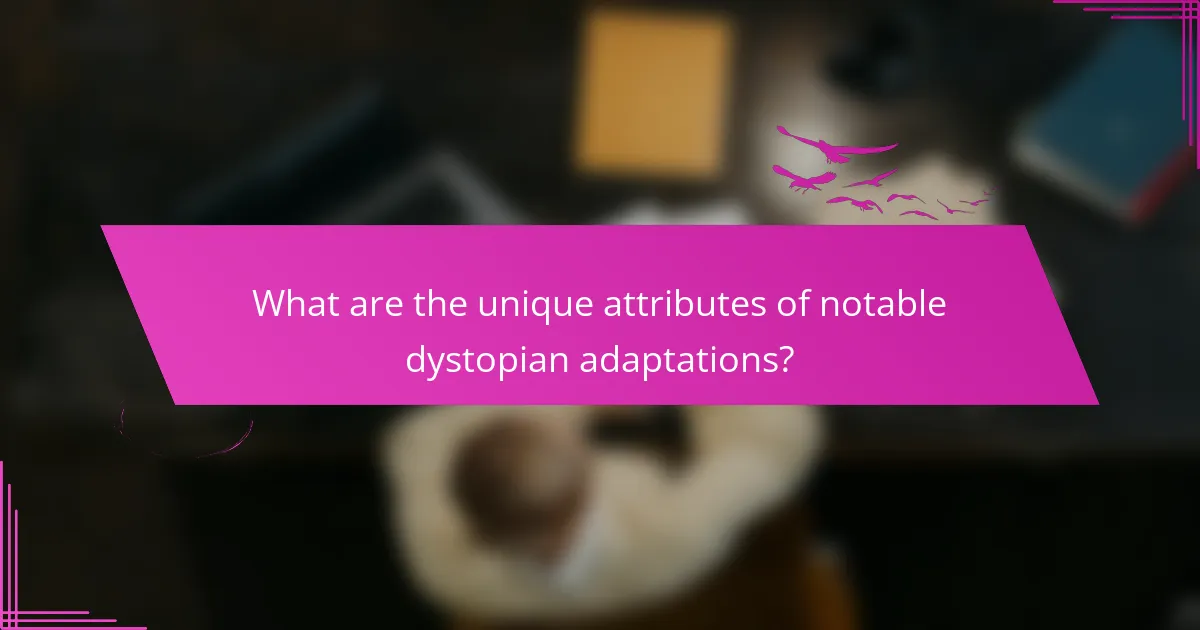
What are the unique attributes of notable dystopian adaptations?
Notable dystopian adaptations feature unique attributes that enhance their narratives and audience engagement. Key aspects include distinctive visual styles, innovative storytelling techniques, and thematic depth that resonate with contemporary issues.
Visual styles often diverge from the source material, providing a fresh aesthetic that captures the essence of dystopian worlds. For example, films like “Blade Runner” employ striking cinematography to create immersive environments.
Innovative storytelling techniques, such as non-linear narratives or multiple perspectives, can differentiate adaptations. “The Handmaid’s Tale” series utilizes a first-person perspective, enriching the viewer’s emotional connection to the protagonist’s struggles.
Thematic depth in adaptations often reflects current societal anxieties, making them more relatable. Works like “Children of Men” explore themes of hope amidst despair, mirroring real-world challenges.
Which adaptations have introduced innovative storytelling techniques?
Innovative storytelling techniques in dystopian cinema often emerge from adaptations of literary works. These adaptations utilize visual elements, nonlinear narratives, and immersive world-building to convey complex themes. For example, “The Handmaid’s Tale” employs a fragmented narrative structure, enhancing emotional engagement. Additionally, films like “Children of Men” utilize long takes to create tension and urgency, illustrating the dire consequences of societal collapse. The integration of technology in storytelling, such as interactive elements in “Black Mirror: Bandersnatch,” further exemplifies innovation in narrative techniques. These approaches redefine audience experience and interpretation of dystopian themes.
How do visual styles differ among various adaptations?
Visual styles in dystopian cinema adaptations vary significantly, reflecting the unique attributes of each literary source. For instance, “Blade Runner” utilizes a neo-noir aesthetic, emphasizing urban decay and isolation, while “The Handmaid’s Tale” employs a stark, oppressive visual palette to convey themes of control. These adaptations often prioritize distinct color schemes and cinematography techniques that resonate with the narrative’s emotional core. Additionally, the choice of visual style can influence audience reception, as seen in the contrasting interpretations of Orwell’s “1984,” where the bleak, desaturated visuals in film adaptations differ from the more vibrant imagery in some graphic novels. Each adaptation’s visual approach serves to enhance or reinterpret the original themes, making the medium’s impact profound and varied.
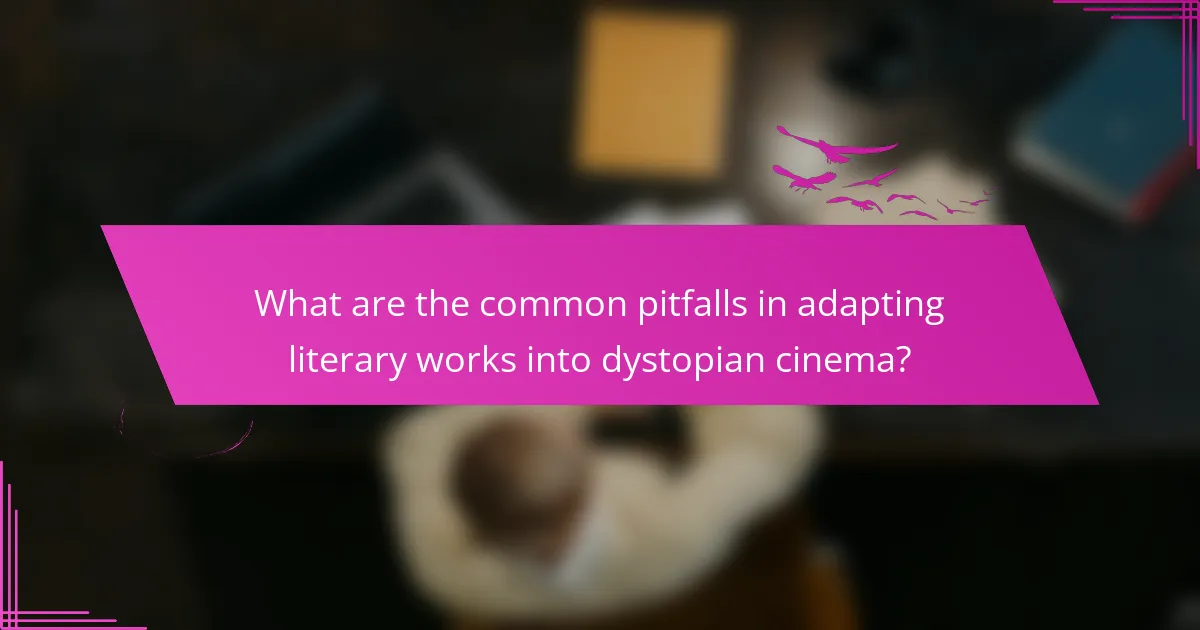
What are the common pitfalls in adapting literary works into dystopian cinema?
Common pitfalls in adapting literary works into dystopian cinema include losing the original narrative’s depth, oversimplifying complex themes, and failing to capture character development. These adaptations often prioritize visual spectacle over substance, leading to a disconnect with audiences familiar with the source material. Additionally, the pacing of a film can compromise the exploration of critical societal issues inherent in the literature. In some cases, unique attributes of the original story may be altered or omitted, diminishing its impact and resonance.
How can filmmakers avoid misrepresenting the source material?
Filmmakers can avoid misrepresenting source material by prioritizing fidelity to the original themes and characters. They should engage with the source material deeply, ensuring they understand the author’s intent and the context of the story. Collaborating with the original authors or literary experts can provide invaluable insights. Additionally, maintaining a balance between creative interpretation and the essence of the source can enhance authenticity. Regular feedback from dedicated fans of the original work can also guide filmmakers in aligning their adaptations with audience expectations.
What lessons can be learned from unsuccessful adaptations?
Unsuccessful adaptations of literary works in dystopian cinema reveal crucial lessons about authenticity and audience expectations. Poorly executed adaptations often stray too far from the source material, losing the essence that resonated with readers. For instance, changes in character motivations or plotlines can alienate fans, leading to negative reception.
Additionally, a lack of coherent vision can result in disjointed narratives that fail to engage viewers. Successful adaptations, in contrast, maintain fidelity to the original themes while ensuring cinematic appeal. Ultimately, understanding the balance between innovation and respect for the source material is vital for future adaptations.
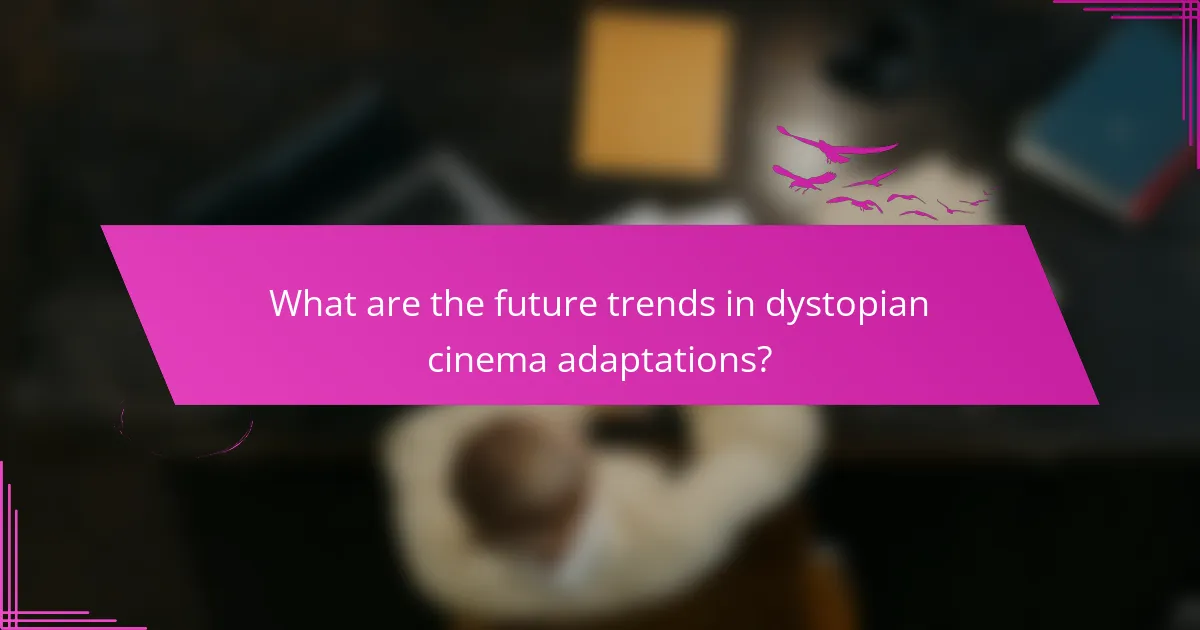
What are the future trends in dystopian cinema adaptations?
Future trends in dystopian cinema adaptations will focus on diverse storytelling and technological integration. Filmmakers are increasingly adapting lesser-known literary works, expanding the genre’s narrative landscape. Enhanced visual effects and virtual reality experiences are expected to immerse audiences in dystopian worlds. Additionally, themes addressing contemporary societal issues will resonate, making adaptations more relatable. As a result, audiences will engage with these films on deeper emotional levels, fostering a renewed interest in the genre.
How might emerging technologies influence future adaptations?
Emerging technologies will significantly shape the adaptations of literary works in dystopian cinema. Innovations in virtual reality, artificial intelligence, and interactive storytelling will enhance audience engagement and narrative depth.
For instance, virtual reality can immerse viewers in dystopian worlds, allowing them to experience stories firsthand. Artificial intelligence may enable personalized narratives, adapting plots based on viewer choices. Additionally, advancements in visual effects can create more realistic portrayals of dystopian settings, enhancing emotional impact.
These technologies may also influence audience reception, as viewers seek more interactive and engaging experiences. The shift towards immersive storytelling could redefine how adaptations are created and consumed, potentially leading to new genres and formats in dystopian cinema.
What new literary works are gaining traction for potential adaptation?
Several new literary works are gaining traction for potential adaptation into dystopian cinema. Notable titles include “The Power” by Naomi Alderman, exploring gender dynamics in a dystopian setting, and “The Water Knife” by Paolo Bacigalupi, which addresses climate change and resource scarcity. “Red Clocks” by Leni Zumas offers a unique perspective on reproductive rights in a near-future society. Additionally, “Children of Time” by Adrian Tchaikovsky presents a fascinating narrative about evolution and survival. These works are attracting attention due to their relevant themes and compelling narratives that resonate with contemporary audiences.
What best practices should filmmakers consider when adapting dystopian literature?
Filmmakers should prioritize authenticity, thematic depth, and visual storytelling when adapting dystopian literature. Engaging with the source material’s core themes ensures the adaptation resonates with audiences. Incorporating unique visual elements can enhance the narrative, making complex ideas accessible. Collaborating with original authors may provide insights that deepen the adaptation’s impact. Understanding audience expectations and contemporary societal issues can also guide filmmakers in creating relevant and thought-provoking content.
